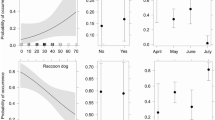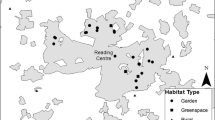Abstract
The purpose of this study is to experimentally determine the differences between four grazing treatments on the trampling of nests. Additionally, we examine to what extent the trampling probability of nests is higher close to a source of fresh water. We compare the trampling of artificial nests in five different grazing treatments in an experimental design. We use buried clay pigeon targets as artificial mimics of bird nests to obtain reliable estimates of trampling risk and compare these with real nests. We find that horses trample significantly more artificial nests than cattle resulting in lower survival rates of artificial nests under horse grazing than under cattle grazing. For both horses and cattle, we find a clear trend, approaching significance, towards more trampling at higher numbers of livestock. We found that more artificial nests are trampled closer to a freshwater tank. The survival probability of artificial nests in cattle grazed treatments in this study is found to be in the same range as real nests in the study area and very close to the survival probability of Northern Lapwing (Vanellus vanellus) nests under cattle grazing in a different system. We recommend that horses should not be used as grazers for management purposes in areas with high densities of birds’ nests in order to minimize the risk of nests being trampled. Additionally, we confirm that the location of freshwater tanks has an important effect on the distribution of livestock and hence on trampling of nests.



Similar content being viewed by others
References
ArcGIS Desktop (2010) Version 10. ESRI Inc.
Arnold GW (1984) Comparison of the time budgets and circadian patterns of maintenance activities in sheep, cattle and horses grouped together. Appl Anim Behav Sci 13:19–30
Bailey DW, Brown JR (2011) Rotational grazing systems and livestock grazing behaviour in shrub-dominated semi-arid and arid rangelands. Rangel Ecol Manag 64:1–9
Bailey DW, Gross JE, Laca EA, Rittenhouse LR, Coughenour MB, Swift DM, Sims PL (1996) Mechanisms that result in large herbivore grazing distribution patterns. J Range Manag 49:386–400
Bakker JP (1989) Nature management by grazing and cutting. Kluwer Academic Publishers, Dordrecht
Bates D, Maechler M, Bolker B (2011) Lme4: Linear mixed-effects models using S4 classes. R package version 0.999375-42. http://CRAN.R-project.org/package=lme4
Bayne EM, Hobson KA (1997) Comparing the effects of landscape fragmentation by forestry and agriculture on predation of artificial nests. Cons Biol 11:1418–1429
Beintema AJ, Moedt O, Ellinger D (1995) Ecologische atlas van de Nederlandse weidevogels. Schuyt & Co Uitgevers en Importeurs, Haarlem
Beintema AJ, Müskens GJDM (1987) Nesting success of birds breeding in Dutch agricultural grasslands. J Appl Ecol 24:743–758
Boulton RL, Cassey P (2006) An inexpensive method for identifying predators of passerine nests using tethered artificial eggs. N Z J Ecol 30:377–358
Duncan P, Foose TJ, Gordon IJ, Gakahu CG, Lloyd M (1990) Comparative nutrient extraction from forages by grazing bovids and equids: a test of the nutritional model of equid/bovid competition and coexistence. Oecologia 84:411–418
Ebrahimi A, Milotić T, Hoffmann M (2010) A herbivore specific grazing capacity model accounting for spatio-temporal environmental variation: A tool for a more sustainable nature conservation and rangeland management. Ecol Model 221:900–910
Frame J, Laidlaw AS (2011) Improved grassland management. The Crowood Press Ltd., Ramsbury
Fuller RJ, Gough SJ (1999) Changes in sheep numbers in Britain—Implications for bird populations. Biol Cons 91:73–89
Ganskopp D (2001) Manipulating cattle distribution with salt and water in large arid-land pastures: a GPS/GIS assessment. Appl Anim Behav Sci 73:251–262
Green RE (1988) Effects of environmental factors on the timing and success of breeding of common snipe Gallinago gallinago (Aves: Scolopacidae). J Appl Ecol 25:79–93
Gregory JS, Gamett BL (2009) Cattle trampling of simulated bull trout redds. N Am J Fish Manag 29:361–366
Hart JD, Milsom TP, Baxter A, Kelly PF, Parkin WK (2002) The impact of livestock on lapwing Vanellus vanellus breeding densities and performance on coastal grazing marsh. Bird Study 49:67–78
Holechek JL (1988) An approach for setting the stocking rate. Rangel 10:10–14
Hothorn T, Bretz F, Westfall P (2008) Simultaneous inference in general parametric models. Biom J 50:346–363
Huijser MP, Kociolek AV (2008) Wildlife-vehicle collision and crossing mitigating measures: A literature review for Blaine county Idaho. Western Transportation Institute, Montana State University, Bozeman
Janis CM, Constable EC, Houpt KA, Streich WJ, Clauss M (2010) Comparative ingestive mastication in domestic horses and cattle: a pilot investigation. J Anim Phys Anim Nutr 94:e402–e409
Jensen HP, Rollins D, Gillen RL (1990) Effects of cattle stock density on trampling loss of simulated ground nests. Wildl Soc Bull 18:71–74
Johnson DH (1979) Estimating nesting success: the Mayfield method and an alternative. Auk 96:651–661
Koerth BH, Webb WM, Bryant FC, Guthery FS (1983) Cattle trampling of simulated ground nests under short duration and continuous grazing. J Range Manag 36:385–386
Lange RT (1985) Spatial distributions of stocking intensity produced by sheep-flocks grazing Australian chenopod shrublands. Trans R Soc S Aust 109:167–174
Liddle M (1997) Recreation ecology: the ecological impact of outdoor recreation and ecotourism. Chapman & Hall, London
MacDonald MA, Bolton M (2008) Predation of Lapwing Vanellus vanellus nests on lowland wet grassland in England and Wales: effects of nest density, habitat and predator abundance. J Ornithol 149:555–563
Maier TJ, Degraaf RM (2001) Difference in depredation by small predators limit the use of plasticine and Zebra Finch eggs in artificial- nest studies. Condor 103:180–183
Major RE (1991) Identification of nest predators by photography, dummy eggs and adhesive tape. Auk 108:190–196
Major RE, Kendal CE (1996) The contribution of artificial nest experiments to understanding avian reproductive success—a review of methods and conclusions. Ibis 138:298–307
Martin TE (1987) Artificial nest experiments – effects of nest appearance and type of predator. Condor 89:925–928
McGowan CP, Simons TR, Golder W, Cordes J (2005) A comparison of American Oystercatcher reproductive success on barrier beach and island habitats in coastal North Carolina. Waterbirds 28:150–155
Menard C, Duncan P, Fleurance G, Georges JY, Lila M (2002) Comparative foraging and nutrition of horses and cattle in European wetlands. J Appl Ecol 39:120–133
Moore RP, Robinson WD (2004) Artificial bird nests, external validity and bias in ecological field studies. Ecol 85:1562–1567
Norris K, Cook T, O’Dowd B, Durdin C (1997) The density of Redshank Tringa totanus breeding on the salt marshes of the Wash in relation to habitat and its grazing management. J Appl Ecol 34:999–1013
Ottvall R (2005) Nest survival among waders breeding on coastal meadows: the relative importance of predation and trampling damages by livestock. Ornis Svecica 15:89–96
Ottvall R, Larsson K, Smith HG (2005) Nesting success in Redshanks Tringa totanus breeding on coastal meadows and the importance of habitat features used as perches by avian predators. Bird Study 52:289–296
Paine L, Undersander DJ, Sample DW, Bartelt GA, Schatteman TA (1996) Cattle trampling of simulated ground nests in rotationally grazed pastures. J Range Manag 49:294–300
Paine L, Undersander DJ, Sample DW, Bartelt GA, Schatteman TA (1997) Technical note: comparison of simulated ground nest types for grazing/trampling research. J Range Manag 50:231–233
Pakanen V-M, Luukkonen A, Koivula K (2011) Nest predation and trampling as management risks in grazed coastal meadows. Biodivers Conserv 20:2057–2073
Pavel V (2004) The impact of grazing animals on nesting success of grassland passerines in farmland and natural habitats—a field experiment. Folia Zool 53:171–178
Picman J (1987) An inexpensive camera setup for the study of egg predation at artificial nests. J Field Ornith 58:372–382
Development Core Team R (2011) R: A language and environment for statistical computing. R Foundation for statistical computing, Vienna
Valentine KA (1947) Distance from water as a factor in grazing capacity of rangeland. J Forestry 45:749–754
Vallentine J (1971) Range Development and Improvements. Young University Press, Provo
Von Blotzheim UNG (2004) Handbuch der Vögel Mitteleuropas. Mit einem Lexikon ornithologischer Fachbegriffe von Ralf Wassmass. Vogelzug-Verlag, Wiebelsheim
Wallander J, Isaksson D, Lenberg T (2006) Wader nest distribution and predation in relation to man-made structures on coastal pastures. Biol Cons 132:343–350
Whittingham MJ, Evans KL (2004) The effect of habitat structure on predation risk of birds in agricultural landscapes. Ibis 146(Suppl 2):210–220
Wilson GR, Brittingham MC, Goodrich LJ (1998) How well do artificial nests estimate success of real nests? Condor 100:357–364
Zuur AF, Ieno EN, Walker NJ, Saveliev AA, Smith GM (2009) Mixed effects models and extensions in ecology with R. Springer Science + Business Media, New York
Acknowledgements
We would like to thank It Fryske Gea for making this study logistically possible and for allowing this study to be conducted on their salt marsh. We thank Pieter-Wytze Venema and Vinh Banh for invaluable help in data collection. Use of data collected by Steffi Nolte and Christa van der Weyde is highly appreciated. Esther Chang, Roel van Klink, Elske Koppenaal and Steffi Nolte provided helpful comments on different parts of this manuscript. The study was funded by the ‘Waddenfonds’
Author information
Authors and Affiliations
Corresponding author
Rights and permissions
About this article
Cite this article
Mandema, F.S., Tinbergen, J.M., Ens, B.J. et al. Livestock grazing and trampling of birds’ nests: an experiment using artificial nests. J Coast Conserv 17, 409–416 (2013). https://doi.org/10.1007/s11852-013-0239-2
Received:
Revised:
Accepted:
Published:
Issue Date:
DOI: https://doi.org/10.1007/s11852-013-0239-2




